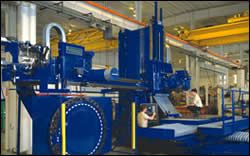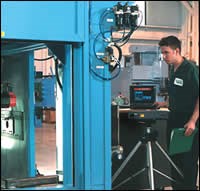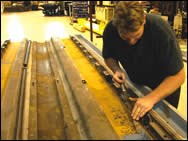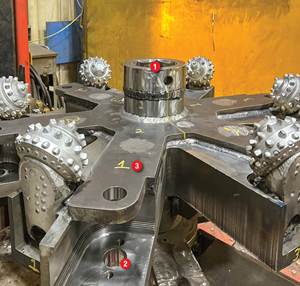Upgrading Machine Tools During A Market Uptick
These guidelines aim to help shops determine whether it is in their best interests to revive existing metalcutting equipment or to buy new machines.
Share







Hwacheon Machinery America, Inc.
Featured Content
View More
Takumi USA
Featured Content
View More
Manufacturing in the United States is picking up, but it certainly hasn't reached full stride. Optimistic shop owners are flipping through machine tool OEM catalogs, browsing Web sites and kicking tires at trade shows. But until shops observe a sustained flow of orders, offering solid evidence that the U.S. metalworking industry truly is back online, many will remain apprehensive about investing in new machines.
But what about breathing new life into tired metalcutting equipment already on the shop floor?
Savvy shops endeavor to upgrade their processes during an economic ebb so they're primed and ready for the flow. Restoring machine tools to OEM performance levels in the "off season" is a good example of prepping for prosperity. For the right piece of equipment, it offers new-machine performance at a fraction of new-machine cost.
For some shops, though, the recent market downturn was an anomaly. There simply were no funds for process improvement. In fact, it was all some shops could do to maintain machines that were still running, let alone upgrade their performance.
Now that the manufacturing sector is getting back on track, the time may be right to revive some old iron. But how do you choose a rebuilder? Would you be better off buying a new machine? Which of your machines should you restore?
These and other questions were addressed by Dave Green, vice president of sales and marketing for Kentucky Rebuild Corporation (Independence, Kentucky). OEM or third-party rebuilders like KRC can examine a machine and, after discerning desired performance and accuracy levels, they can make the mechanical repairs and/or electrical changes needed to extend the machine's production life. In addition, rebuilders often can customize machines with features specifically tailored to a shop's process.
Candid rebuilders will also tell you when it's not in your best interests to upgrade a machine.
Restoration Definitions
The term "rebuild" is commonly thrown around to describe a machine restored to OEM performance levels. However, there are varying degrees of machine restoration. This can lead to confusion when talking with rebuilders, as the industry has yet to standardize its restoration terminology.
To make things clear for its customers, KRC distinguishes three main categories: rebuild, retrofit and remanufacture. Each of these can, and often does, include some customization, depending on process requirements and part availability.
- A rebuild is a complete restoration of the machine's mechanical components. This is typically done to machines that are 10 to 15 years old and have a reliable CNC.
- A retrofit involves upgrading the control and replacing all the electronics, including wiring, servos and drives. This makes sense for mechanically sound machines that have a defective or outdated CNC. A CNC can be added to some manual machines.
- A remanufacture is a combination of both rebuild and retrofit, and it often is performed on machines costing in excess of $400,000 when new. "Remans" typically receive the highest degree of customization.
Are You A Candidate?
For most of KRC's projects, especially remanufactures, customers tend to be mid- to large-sized companies with a sizeable stable of machines. A small company considering restoration work must be sure it can endure the production that will be lost while its machine is being restored.
A shop that can't afford to take a machine offline for restoration may opt to purchase a new machine if it has available floorspace. That way, the existing machine can continue making chips while the new one is installed. The old machine also may have resale value, which could be put towards the purchase of a new machine.
According to Mr. Green, turnaround time for restoration projects can be quicker than new machine delivery. Typically:
- A remanufacture of big or complex machines takes 20 to 24 weeks.
- A rebuild takes 14 to 16 weeks.
- A retrofit takes anywhere from 1 to 10 weeks, depending on the how fast the rebuilder can take delivery of the control, the extent of wiring replacement, size of the machine and so on.
With the exception of retrofits, machines typically are disassembled and transported to the rebuilder's facility for restoration. After completion, the machines are laser calibrated, and preliminary runoff is performed. They are then dismantled and delivered to the customer's shop for final runoff. The rebuilder will laser calibrate the machines again once they are installed at the customer's shop, unless the customer would rather leave that to its own maintenance crew.
Payment plans will vary from rebuilder to rebuilder. The payment schedule for many rebuilders includes an initial down payment to start work, a second payment due at first runoff and final payment contingent upon runoff at the customer's facility. While you may be able to negotiate payment percentages for each stage, keep in mind that the initial down payment may not be enough to cover the rebuilder's own cost for the control.
Is Your Machine A Candidate?
Mr. Green says some shops have a perception that restorations are very inexpensive, or that any of their machines could be restored. While it is true that just about any machine could be restored, not every machine should be restored.
The 60 percent rule is the industry's fundamental tenet for determining whether to restore or replace a machine. Simply stated, if the cost to restore is less than 60 percent of a comparable new machine's price, restore it. If the cost is above that, buy new.
Retrofits and rebuilds usually have no problem getting under the 60 percent limit. In fact, retrofits sometimes cost only 30 percent of a new machine's price, according to Mr. Green.
Because of the amount of work involved, complete remanufactures come closest to hitting the 60 percent ceiling and often exceed it if the machine is relatively small. This is why remanufactures typically are reserved for sizable machines like boring mills, large-chuck lathes and big-table horizontals. This is also what nixes any notions of remanufacturing small VMCs or HMCs. As new machines continue to shrink in price and improve in terms of speed, accuracy and multitasking capabilities, it is nearly impossible for small used machines to get under the 60 percent limbo pole.
"Understandably, small shops may have an emotional attachment to their first machine," Mr. Green explains, "perhaps a $30,000 VMC they mortgaged their house to buy. They must realize that it would take more money to restore it than to buy new. Some have a hard time dealing with this. Part of our job is explaining to them that restoring the machine is not in their best interests."
Mr. Green identifies four commonly remanufactured machines and suggests the following respective minimal sizes to meet the 60 percent rule:
HMCs should have a minimum of an 800-mm table. Vertical boring mills should have a minimum of a 48-inch diameter table. Horizontal boring mills should have a minimum of a 5-inch diameter spindle. Horizontal slant bed lathes should have a minimum of a 28-inch chuck. The exception to this is very long-bed lathes commonly used in the oil industry.
The 60 percent rule is not absolute, though. Consider new machine ancillary costs. Will you need to add a foundation or rearrange the shop? Will you need to purchase new tooling or fixturing? Will you be able to run the same part program, or will you need another post processor to generate the correct code to match a new CNC? These "little" things add up quickly in terms of cost and complications, and they may make restoration a more attractive alternative, even if you are close or over the 60 percent limit From a mechanical standpoint, a restored machine's basic components likely won't be altered unless the machine design is dramatically customized. That means the maintenance crew will have an instant comfort level with the machine after restoration. But with a new machine, there may be a mechanical learning curve, especially if the machine has components such as linear guides or linear motors that the previous machine didn't have. Maintenance might not want to touch it.
Another consideration is the capability to customize. A machine might be very close to the 60 percent limit, but if its capabilities can be expanded by fitting it with an additional spindle, extending axis travels or adding a toolchanger, it may make more sense to restore it.
Be sure you and your restoration suitors understand your processing needs. Will your process be optimized by switching to a new machine with higher feeds or speeds, or other special capabilities? If you just wish to continue doing what you've been doing but in a more reliable manner, it may pay to restore.
For example, you can only go so fast when cutting Inconel, so chances are that a new machine with faster feed rates wouldn't improve the process. In that respect, the high speed capabilities would be wasted. However, if you are looking for greater processing flexibility, perhaps hoping to feed multiple jobs or materials to one machine, then a customized remanufacture or new machine are both good options.
Choose Wisely
Like any new machine purchase, the decision to retrofit, rebuild or remanufacture should not be rushed. Mr. Green recommends keeping a number of things in mind when choosing and dealing with a machine rebuilder.
Get it in (clear) writing—Make sure the rebuilder's quote is descriptive and complete, clearly listing all services to be provided, results desired, support documentation to be included and warranty provided.
Consider rebuilder expertise—If your shop has a variety of machine types (mills, lathes and so on) that may be restoration candidates, look for a rebuilder that has experience with many machine types and grow a relationship with that rebuilder. If your equipment is limited to one machine type, you may wish to go to the OEM or a rebuilder that specializes in that machine.
Look for repeat business—If you see that companies have used the same rebuilder multiple times, consider that a sign that the rebuilder delivers what it promises.
Get a second opinion—Be sure to get quotes from multiple rebuilders.
Think with your head, not your heart—Actually, think with your wallet. Don't take it personally when a rebuilder is honest enough to say your machine is not worth being rebuilt. It may be the machine that started it all for you, but the rebuilder is looking out for your company's best interests by recommending that you buy new.
Ballbar bargaining—If you have the capabilities to laser and ballbar your machines, you may be able to cut a small portion of the cost by doing those tasks yourself after delivery instead of having the rebuilder do them.
Proprietary perils—Ask if the rebuilder uses proprietary or OEM components. If it makes its own parts, then you'll have to go back to that rebuilder for replacement. If it uses OEM parts when possible, you can go straight to the OEM with the correct part number.
Application software—Be sure you will receive a fully cross-referenced ladder or soft-logic diagram. This is essential for effective machine troubleshooting.
Check the classifieds—Follow the used machine market and watch for auctions. You may be able to pick up a decent used machine cheap and immediately have it restored or customized. Rebuilders may be able to assist you in finding an appropriate used machine.
Get it in writing, again—The amount of support documentation you receive will depend on the type of restoration work you are having done. For complete remanufacture, you should get an operator's manual; all electrical drawings (paper and electronic on CD); all drawings of any custom components; full laser and ballbar data; results of any special tests, such as horsepower cuts; and a complete bill of materials, including vendor part numbers.
Related Content
Select Machining Technologies Highlights Multitasking Machines
IMTS 2024: Select Manufacturing Technologies is highlighting large-capacity multitasking machines from Solace, Geminis, Ibarmia and Momentum.
Read MoreThe Cut Scene: The Finer Details of Large-Format Machining
Small details and features can have an outsized impact on large parts, such as Barbco’s collapsible utility drill head.
Read MoreESOP Solidifies Culture of Continuous Improvement
Astro Machine Works’ ESOP rewards all employees when the shop does well, inspiring many toward continuous improvement as Astro expands its capabilities.
Read MoreHow a Custom ERP System Drives Automation in Large-Format Machining
Part of Major Tool’s 52,000 square-foot building expansion includes the installation of this new Waldrich Coburg Taurus 30 vertical machining center.
Read MoreRead Next
Registration Now Open for the Precision Machining Technology Show (PMTS) 2025
The precision machining industry’s premier event returns to Cleveland, OH, April 1-3.
Read More5 Rules of Thumb for Buying CNC Machine Tools
Use these tips to carefully plan your machine tool purchases and to avoid regretting your decision later.
Read MoreBuilding Out a Foundation for Student Machinists
Autodesk and Haas have teamed up to produce an introductory course for students that covers the basics of CAD, CAM and CNC while providing them with a portfolio part.
Read More




































.jpg;maxWidth=300;quality=90)




















